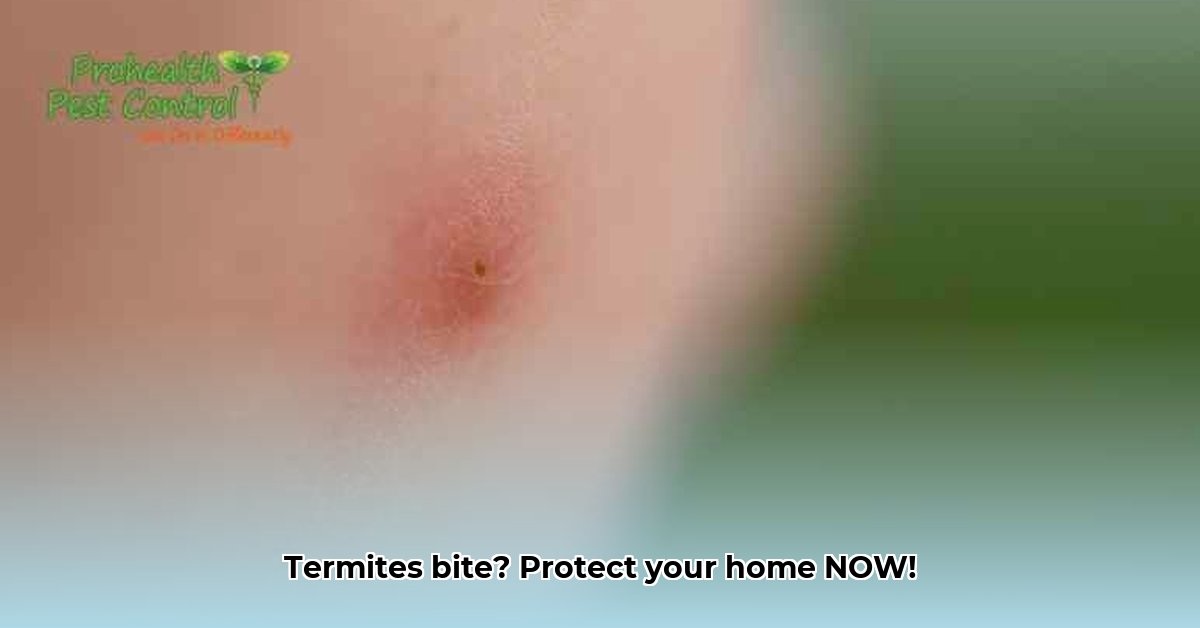Ever heard the rumor that termites bite? It’s a scary thought, but the reality is much less dramatic. While a termite could technically nip you, it’s incredibly rare. The real danger isn’t tiny bites, but the massive damage termites can do to your house – think thousands of dollars in repairs and potential safety hazards. High humidity can worsen the problem, so learn more about humidity control. This guide will cut through the myths and give you the practical know-how to protect your home, focusing on termite control and termite prevention. We’ll cover what termites are, why you’re unlikely to get bitten, and, most importantly, how to prevent a full-blown infestation before it starts costing you big time.
Do Termites Bite People? Identifying Termite Species
Let’s tackle a common question: Do termites bite? The short answer is yes, but it’s incredibly rare. Think of it like this: you’re much more likely to stub your toe than get bitten by a termite. While the bite itself isn’t a major health concern, the real danger from termites is far more significant – and that’s the damage they do to your home. Let’s delve deeper into termite behavior to understand how we can protect our homes and families from this pest.
Understanding the Tiny Tenants in Your Walls: Termite Colony Structure
Termites aren’t just single bugs; they live in massive, highly organized colonies. Imagine a tiny city, each termite with a specific job. You’ve got the workers, constantly munching on wood; the soldiers, the colony’s protectors equipped with powerful jaws (mandibles); and the reproductives (also known as alates), responsible for creating new termites. What role does each termite caste play in termite colony structure?
It’s the soldiers, those little armored guys, that might bite, but it’s really a last resort – like a security guard making a desperate move. They’re only likely to bite if they feel their home (your house) is under attack, feeling threatened and cornered. Different termite types – subterranean termites that live underground, drywood termites nesting within wood, and dampwood termites preferring moist wood – have different chances of bumping into humans. Some are more likely to stay hidden than others.
The Truth About Termite Bites: More Hype Than Harm: Reaction to Termite Bites
Let’s be realistic: a soldier termite bite is a minor irritation at best. Most people describe the feeling as a tiny pinprick, much like a mosquito bite. You might experience a little redness or itching afterward, similar to a mosquito bite. In extremely rare cases, someone might have an allergic reaction, but this is more unusual than winning the lottery. It usually involves just a little extra swelling and itching that responds well to basic first aid with over-the-counter antihistamines or topical creams. Don’t let exaggerated stories scare you; it’s far more likely you’ll experience a minor nuisance than a serious medical event.
The Real Enemy: Termite Damage – A Silent Demolition Crew: Identifying Termite Damage
The real threat from termites is far more menacing than a rare bite: the extensive damage they inflict on your home. These tiny creatures are silent destroyers, gradually weakening the structural integrity of your house. Think of them as a miniature demolition crew working tirelessly day and night. They might start small, but over time, their tireless chewing can create serious problems—far more serious than a tiny bite could ever be.
Imagine these tireless workers creating intricate networks of tunnels inside your walls, floorboards, and even the foundation of your home. This unseen destruction can lead to costly repairs, and in severe cases, could even create safety hazards, risking structural failure. This silent destruction is the true concern, much more worrisome than a tiny bite. Look for buckling wood, hollow sounds when tapping walls, or discarded wings as signs of termite damage.
Preventing Termite Damage: A Proactive Approach to Home Protection: Termite Prevention Strategies
The good news is that you can significantly reduce the risk of termite damage through proactive and regular preventative measures. Here’s a step-by-step guide to termite prevention strategies:
Step 1: Regular Home Inspections – Become a Termite Detective
Conduct thorough inspections of your home monthly. Pay special attention to areas prone to moisture like bathrooms, kitchens, and basements. Look for telltale signs: mud tubes (basically, termite highways) along your foundation, damaged wood, or any evidence of water damage. Early detection is key. What are the key indicators during regular home inspections to identify a potential termite infestation? Check for sagging floors, discolored drywall, and pinpoint holes in wood surfaces.
Step 2: Conquer the Moisture – Termites Love Dampness
Termites thrive in damp conditions. Address any moisture issues promptly. Repair any leaky pipes or faucets immediately. Ensure proper ventilation in attics and crawl spaces to reduce humidity—a dry environment is a termite’s worst nightmare. Consider using a dehumidifier in damp basements or crawl spaces.
Step 3: Seal Up Entry Points – Block the Highways
Caulk and seal any gaps, cracks, or crevices in your home’s foundation and walls to prevent termites from entering in the first place. Pay close attention to areas where pipes and wires enter the house. Think of it as building a strong barrier around your home. Use weather stripping around doors and windows to further seal your home.
Step 4: Enlist Professional Help – The Expert Eye
Schedule a professional termite inspection every 1-2 years, or sooner if you have any suspicions. Professional pest control experts possess the skills and knowledge to detect hidden infestations and recommend suitable treatment. How often should professional termite inspections be conducted to ensure timely detection? Homes in areas with a high termite risk should be inspected annually; otherwise, every two to three years is sufficient.
Step 5: Preventative Treatments – Long-Term Protection
Discuss preventative treatments with professionals. They can offer various options, some providing a significant deterrent against termites for a prolonged period. Soil treatments, wood treatments, and baiting systems are common preventative measures.
What to Do If You Think You Have a Termite Problem: Termite Infestation Management
If you suspect a termite infestation, don’t panic but act quickly. Contact a trusted pest control company right away. A qualified expert will perform a thorough inspection to assess the extent of the damage and recommend the best course of action. Early intervention significantly reduces the risk of extensive damage and keeps your home safe and sound.
A Quick Comparison: The Real Risks: Termite Risk Assessment
| Risk Factor | Probability | Severity | Cost Implications |
|---|---|---|---|
| Termite Bite | Extremely Low | Minor Irritation | Usually negligible |
| Structural Damage | Significantly Higher | Potentially Catastrophic | Very High |
The Bottom Line: While a termite bite is possible, the odds are overwhelmingly against it. Your energy is far better spent on preventing the significant structural damage they can cause. Regular checks, moisture control, and professional help are your best defense against these silent home invaders.
How to Prevent Costly Termite Damage Through Early Detection: Steps for Early Termite Detection
Key Takeaways:
- Termite bites are rare, but the structural damage they cause is a significant threat.
- How to Prevent Costly Termite Damage Through Early Detection relies on proactive inspections and environmental control.
- Addressing moisture issues is crucial in preventing termite infestations.
- Professional inspections and treatments are vital for effective termite control.
Understanding Termites and Their Behavior: Termite Social Structure
Let’s address the elephant in the room: Do termites bite? While some species might nip, it’s exceedingly rare. Soldier termites, with their powerful mandibles, are the culprits. However, their bite is typically a minor annoyance, causing a sensation similar to a pinprick. Far more concerning is the extensive damage these insects can inflict on your home’s structure. How does understanding termite social structure aid in effective termite prevention?
Termites are social insects living in complex colonies. They have distinct castes: workers, soldiers, and reproductives (alates). Workers are responsible for foraging and building, soldiers defend, and reproductives ensure colony growth. Different termite species (subterranean, drywood, dampwood) have varying habits, influencing how they interact with your home and how you should approach How to Prevent Costly Termite Damage Through Early Detection. For example, knowing subterranean termites build mud tubes helps you identify potential entry points along your foundation.
The Real Danger: Structural Damage: Types of Termite Damage
Forget the slight possibility of a bite; the true danger from termites is the massive structural damage they cause. These tiny creatures can eat away at the very foundation of your house, causing significant, costly repairs and even compromising safety. Imagine the expense of repairing beams, floors, or walls—not to mention the inconvenience and stress. Pictures of termite-ravaged wood clearly illustrate the extent of the problem. Protecting your home from termites is a serious investment in its longevity and your peace of mind. What are the specific indicators of types of termite damage that homeowners should check for? Look for hollow-sounding wood, unexplained piles of sawdust, and doors or windows that are difficult to open or close. Also, be aware of bubbling paint, which can be a sign of moisture and termite activity.
Implementing a Proactive Prevention Plan: Proactive Termite Prevention
How to Prevent Costly Termite Damage Through Early Detection requires a multifaceted approach:
- Gluten Free Meal Prep Ideas for Delicious, Hassle-Free Eating - November 28, 2025
- Gluten Free Meal Prep for Stress-Free and Healthy Eating - November 27, 2025
- Quick And Easy Chicken Thigh Meal Prep For Weight Loss - November 26, 2025










